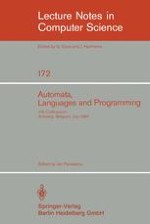1984 | Buch
Automata, Languages and Programming
11th Colloquium Antwerp, Belgium, July 16–20, 1984
herausgegeben von: Jan Paredaens
Verlag: Springer Berlin Heidelberg
Buchreihe : Lecture Notes in Computer Science
Enthalten in: Professional Book Archive
